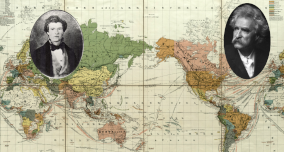Before European settlers arrived, there was a Native American village in what is today downtown Aurora, on the banks of the Fox River. In 1834, following the Black Hawk War, the McCarty brothers settled on both sides of the river, but subsequently sold their land on the west side to the Lake brothers, who opened a mill. The McCartys lived on and operated a mill on the east side.[9] Aurora was established with the building of a post office in 1837.
Aurora began as two villages: East Aurora, incorporated in 1845[10] on the east side of the river, and West Aurora, formally organized on the west side of the river in 1854.[10] In 1857, the two towns joined, incorporating as the city of Aurora.[11] Representatives could not agree which side of the river should house the public buildings, so most of them were built on or around Stolp Island in the middle of the river.
As the city grew, it attracted numerous factories and jobs. In 1849, after failing to attract the Galena and Chicago Union Railroad building west from Chicago, the Aurora Branch Railroad was chartered to build a connection from Aurora to the G&CU at a place called Turner Junction, now West Chicago. Additional lines were built, including a direct line to Chicago, and in 1855 the company was reorganized into the Chicago, Burlington and Quincy Railroad.[12][13] The CB&Q located its roundhouse and locomotive shop in Aurora, becoming the town's largest employer until the 1960s. Restructuring in the railroad industry resulted in a loss of jobs as passenger traffic dropped and the number of railroads decreased. The Burlington Railroad ran regularly scheduled passenger trains to Chicago.[14] Other railroads built lines to Aurora, including the Chicago & Northwestern Railway to Geneva,[15] the Elgin, Joliet and Eastern Railway to Joliet,[16] Chicago, Milwaukee & Gary to Rockford,[17] and the interurbans Chicago Aurora and Elgin Railroad, Aurora, Elgin and Fox River Electric Company, Chicago, Aurora and DeKalb Railroad, and Aurora, Plainfield and Joliet Railroad. With the exception of the EJ&E main line on the east side of the city, all lines other than the former Burlington lines have been abandoned.
